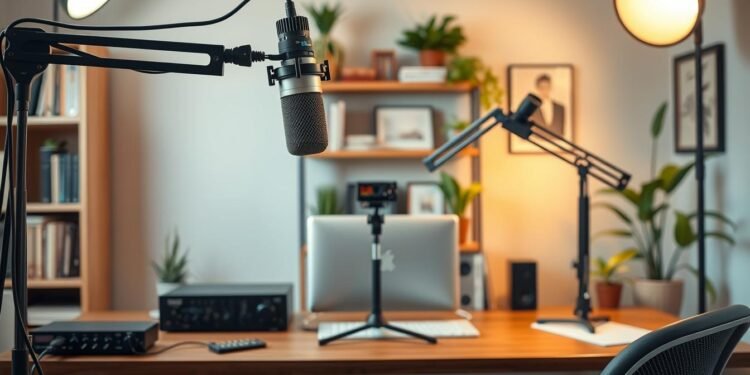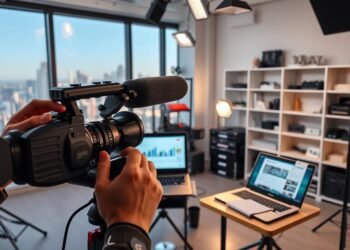Ever wondered why some podcasts thrive while others fade away? The difference lies in planning, execution, and consistency. Launching a successful show requires more than just a microphone—it demands strategy, creativity, and the right tools.
This guide simplifies the process with actionable steps. From selecting equipment to building an audience, every detail matters. Whether you’re a beginner or expanding into audio, these insights help avoid common pitfalls.
Key Takeaways
- Learn essential gear and software for professional sound quality.
- Develop a unique concept to stand out in a crowded space.
- Follow branding best practices for lasting listener engagement.
- Adopt sustainable habits to prevent show abandonment.
- Grow your audience with proven promotional strategies.
How to Start a Podcast: A Beginner’s Guide
The rise of on-demand audio has transformed how audiences consume content. With platforms like Spotify hosting 250,000+ video podcasts, this media format offers unmatched reach. Whether building authority or sharing stories, audio creates intimate connections.
Why Podcasting Is Worth Your Time
Podcasting builds trust. 74% of listeners explore brands mentioned in episodes, making it a powerful marketing tool. Services like Buzzsprout have helped 300,000+ creators since 2009, proving its accessibility.
Video podcasts surged 450% since 2022, appealing to broader audiences. Even niche topics thrive—take “Australian Birth Stories,” which topped charts without an initial following.
Common Myths About Starting a Podcast
Myth 1: You need expensive gear. A $70 Samson Q2U microphone delivers professional sound. Myth 2: Instant fame is guaranteed. Reality? 85% of shows see under 500 downloads per episode.
Artwork matters too—62% of listeners judge a podcast by its cover. Focus on consistency and quality, not overnight success.
Develop Your Podcast Concept
A strong concept separates forgettable shows from must-listen podcasts. Your core idea influences everything from equipment choices to marketing strategies. Spend time refining this foundation before recording begins.
Define Your Goals and Purpose
Business podcasts typically pursue either lead generation or thought leadership. The first focuses on converting listeners, while the second builds industry authority. Choose based on whether you want immediate sales or long-term influence.
For personal shows, consider your “why.” Is it sharing expertise, documenting a journey, or creating community? Document three measurable objectives like “reach 1,000 monthly downloads by Q3.”
Choose a Topic You’re Passionate About
Niche topics outperform broad categories. Compare “Mental Health for Trial Lawyers” to general wellness content—the specific angle attracts a dedicated audience. Your enthusiasm fuels consistency, which 52% of abandoned podcasts lacked.
Test your concept by brainstorming 10 episode ideas. If you struggle, the topic might lack depth. The “Drone Racing Insider” show succeeded by avoiding generic drone content and focusing on competition strategies.
Research Your Competition
Analyze Apple Podcasts search results for your keywords. Note gaps in competitors’ content—maybe they ignore beginner perspectives or skip case studies. The Smart Passive Income podcast grew to 850+ episodes by specializing in actionable business tactics.
Look for underserved angles in saturated markets. A true crime podcast could stand out by focusing exclusively on solved cases or forensic science breakthroughs. Your unique perspective becomes your competitive edge.
Pick the Right Podcast Format
Your podcast’s structure shapes its identity and audience engagement. The format determines production workflow, guest involvement, and listener expectations. Nearly 60% of abandoned shows suffered from mismatched formats that didn’t align with creator energy levels.
Solo, Co-Hosted, or Interview Style?
Solo formats suit introverts with deep expertise—think scripted narratives or commentary. Requires 40% less production time but demands strong vocal presence. The “Philosophize This!” show proves single-host success.
Co-hosted dynamics create natural banter, ideal for comedy or debate podcasts. Chemistry matters—test with trial recordings before committing. Tools like Riverside maintain studio-quality audio for remote duos.
Interview shows leverage guest networks but require rigorous scheduling. Top business podcasts use this format for cross-promotion. Prep 10+ questions per guest to maintain flow.
Optimizing Episode Structure
Buzzsprout data reveals 31% of successful episodes run 20-40 minutes. Fiction podcasts need triple the editing time due to sound effects. Match duration to content depth—microcasts (under 15 minutes) work for daily news.
Publish frequency impacts retention. While 39% of creators release every 8-14 days, Serial’s biennial model proves consistency matters more than speed. Build a 3-episode buffer to avoid gaps during busy periods.
Analyze your audience’s habits. Commuters prefer 30-minute episodes, while niche hobbyists tolerate longer formats. Test different lengths and track listener drop-off points in analytics.
Choose a Memorable Podcast Name
Your podcast’s name is the first impression listeners encounter—make it unforgettable. A strong title boosts discoverability and sets the tone for your show. Apple Podcasts indexes titles in search results, so clarity matters as much as creativity.
Crafting a Standout Title
72% of top-performing podcast names use three words or fewer, like “Stuff You Should Know.” Avoid keyword stuffing—Apple may reject overly long titles. Instead, focus on brand alignment. For example, “Smart Passive Income” clearly targets entrepreneurs.
Test your name’s appeal: Say it aloud and check for awkward phrasing. Ensure it reflects your theme without limiting future growth. A travel podcast named “Backpacking Europe” might struggle to cover global destinations later.
Verify Availability Across Platforms
Use Namecheckr.com to confirm your show name isn’t taken on Apple Podcasts, Spotify, or social media. Secure matching handles (@PodcastName) to avoid audience confusion. Trademark conflicts can derail growth—search USPTO.gov before finalizing.
Case in point: “The Daily” by The New York Times thrived due to its simplicity and brand synergy. Your title should be equally distinctive yet scalable.
Write a Compelling Podcast Description
Your podcast description is the digital handshake that invites listeners in. With a 4,000-character limit, every word must serve a purpose—especially the crucial first 150 characters visible in directory previews. This text determines whether potential subscribers click play or scroll past.
Key Elements of a Great Description
Start with a pain-point hook like “Struggling to grow your small business?” followed by your value proposition. Top shows blend credibility markers (“Hosted by NPR veterans”) with clear content promises (“Weekly interviews with Fortune 500 CEOs”).
Include a call-to-action—whether requesting reviews or social follows. Cohost AI studies show descriptions with CTAs convert 28% better. For episodic shows, note your publishing schedule to set expectations.
Incorporating Keywords for Discoverability
Strategic keywords help algorithms match your podcast with the right audience. Tools like Ahrefs Podcast Keyword Explorer reveal high-traffic terms in your niche. Limit to 3-5 core phrases to avoid sounding robotic.
Test variations through A/B testing—some creators see 40% more clicks by swapping single words. Remember: Your description should read naturally while packing SEO value. It’s the bridge between your content and its ideal listeners.
Select Your Podcast Equipment
Professional sound starts with smart equipment choices. The right setup balances budget and audio quality, ensuring your content stands out in crowded directories. Beginners often overbuy or underestimate needs—this guide simplifies the process.
Essential Gear for Beginners
Every setup requires core components. A reliable microphone captures your voice clearly, while headphones monitor audio quality during recording. The Focusrite Scarlett 2i2 interface ($165) converts analog signals with studio precision.
Accessories matter too. The RØDE PSA1 boom arm ($110) reduces desk noise, while pop filters prevent plosive sounds. For mobile setups, Zoom H6 field recorders capture interviews anywhere.
Microphone Recommendations
Your mic determines 80% of perceived quality. The $70 Samson Q2U delivers professional results for beginners, with both USB and XLR connections. Upgrade to the $400 Shure SM7B later for broadcast-grade clarity.
Positioning affects performance. Keep the mic 2-4 inches off-axis with a pop filter. Test different angles to find your clearest tone.
Budget-Friendly Setup Options
Great sound doesn’t require massive investments. Start with USB mics like the Audio-Technica ATR2100x for plug-and-play simplicity. Acoustic treatment can wait—hang moving blankets as temporary sound dampeners.
Consider future needs when choosing equipment. XLR mics allow upgrades, while USB models limit expansion. Business policies sometimes cover gear, so check your insurance options.
Choose Your Podcast Software
Your audio quality depends as much on digital tools as physical equipment. The right software streamlines recording, enhances clarity, and polishes raw files into professional episodes. Whether editing interviews or hosting remote guests, these platforms shape your show’s technical excellence.
Recording Software Options
Latency tests reveal key differences between top platforms. Riverside.fm ($15/month) maintains sub-500ms delays, while SquadCast ($12/month) excels at multi-track separation. Both preserve audio integrity better than browser-based alternatives.
For solo creators, GarageBand offers intuitive workflows with drag-and-drop simplicity. Audacity remains a free alternative but requires manual configuration. Always test recording software with your specific microphone before committing.
Editing Tools for Beginners
Descript revolutionizes post-production with Overdub voice cloning and text-based editing. Hindenburg Pro automatically balances speech levels—ideal for interview-heavy shows. Adobe Enhance Speech cleans background noise without complex filters.
Cloud backups prevent file disasters. Backblaze offers unlimited storage for large audio projects, while Google Drive simplifies team collaboration. Schedule editing sessions when your ears are freshest—morning hours often yield better results.
Remote Interview Platforms
Video podcasters need reliable solutions for guest recordings. Riverside’s end-to-end encryption protects sensitive conversations, while SquadCast’s auto-reconnect handles spotty internet. Integrate Calendly to streamline scheduling without back-and-forth emails.
Always conduct tech checks before interviews. Test microphones, cameras, and internet speeds with guests 15 minutes early. These software choices form the invisible backbone of every professional production.
Set Up Your Recording Space
Background noise is the silent killer of professional podcast recordings. Even the best equipment struggles in poor environments. A well-planned space preserves audio quality and reduces editing time.
Creating a Quiet Environment
Aim for a 65dB noise floor—about as loud as a quiet conversation. Close windows to block traffic sounds. Turn off HVAC systems during recording sessions.
Closets work surprisingly well. Hanging clothes absorbs echoes. For mobile setups, the Kaotica Eyeball isolates microphones in noisy spaces.
Soundproofing Tips
Bass traps in corners reduce low-frequency reverb. Use Audacity’s noise profile tool to identify persistent hums or buzzes.
Tennis ball mic mounts minimize desk vibrations. Notify neighbors about your recording schedule to avoid interruptions. Simple fixes yield studio-level results.
Record Your First Episode
The moment has arrived—your first episode recording sets the tone for your entire podcast journey. Whether scripting or improvising, clarity and confidence matter. Nearly 80% of listeners overlook minor stumbles, so focus on delivering value.
Preparing Your Script or Outline
A structured template ensures smooth flow. Start with a teaser hook, followed by an intro, segments, and a call-to-action. Vocal warm-ups like tongue twisters reduce slips during recording.
For interviews, share technical checklists with guests beforehand. Label files clearly (e.g., “Episode_001_Raw”) to streamline editing later.
Microphone Techniques for Clear Audio
Angle your mic 45 degrees to minimize plosive sounds. Test levels in Audacity—aim for -12dB peaks. Always record a backup track on your phone for safety.
Keep hydration nearby to maintain vocal clarity. Remember, audio quality often outweighs perfection in delivery.
Edit Your Podcast Audio
Polishing raw recordings transforms amateur content into professional-grade episodes. Strategic editing removes distractions, balances volume, and sharpens your message. This step turns good ideas into great listening experiences.
Basic Editing Steps
Begin with noise reduction. Set gates at -40dB to eliminate background hums. Normalize audio to -3dB RMS for consistent playback across platforms.
Trim long pauses and verbal stumbles. Aim for natural flow—over-editing can sound robotic. Use LUFS meters to hit -16 to -14 loudness standards. This ensures compatibility with Spotify and Apple Podcasts.
Adding Music and Transitions
Intro jingles set the tone. Source royalty-free tracks from FreeMusicArchive.org or AudioJungle. Match music energy to your content—upbeat for interviews, mellow for storytelling.
Crossfades smooth segment transitions. Use 1.5-second fades for quick cuts, 3 seconds for emotional pauses. Always credit artists in ID3 tags to avoid copyright issues.
Export final mixes as MP3 (128kbps) for distribution. Archive lossless WAV files for future remixes. The right software saves hours—tools like Audacity or Descript simplify complex edits.
Create Professional Podcast Artwork
Listeners judge books by covers—and podcasts by their thumbnail designs. Your artwork is the first visual touchpoint in directories like Apple Podcasts. At 3000x3000px RGB, it must captivate at both full size and 55px previews.
Design Tips for Standout Cover Art
Prioritize legibility. Test thumbnails on phones—busy designs blur at small sizes. Use high-contrast colors: blue builds trust, red creates urgency. The “Serial” show evolved its artwork to reflect darker narrative tones over seasons.
Pair fonts strategically. Combine a bold sans-serif for titles with a readable serif for subtitles. Avoid more than two typefaces. Always license Shutterstock images legally to prevent takedowns.
Tools for DIY Artwork
Canva Pro offers drag-and-drop templates with brand kits. Adobe Express provides advanced typography controls. For custom designs, 99Designs contests average $299 with 30+ artist submissions.
Match your artwork to your media strategy. Video podcasts benefit from motion graphics previews. These tools simplify professional results without design expertise.
Set Up Podcast Hosting
Behind every successful podcast lies a robust hosting foundation that ensures seamless delivery to listeners worldwide. Your hosting platform stores audio files, generates critical analytics, and distributes content across directories. Choosing wisely impacts everything from load speeds to monetization potential.
Choosing a Hosting Platform
Key features separate premium services from basic options. IAB-certified analytics provide accurate download metrics advertisers trust. Buzzsprout’s Magic Mastering ($6/episode) automatically enhances audio quality with AI-driven leveling.
Evaluate CDN performance—Libsyn delivers 99.9% uptime, while Captivate offers faster EU streaming. For GDPR compliance, ensure your provider offers regional data storage options. Always verify RSS feed migration support; 301 redirects preserve subscriber counts when switching services.
Uploading Your First Episode
Prepare files in approved formats (MP3, 128kbps minimum) with proper ID3 tags. Triple redundancy backups prevent data loss—services like Backblaze automatically archive raw files. Custom domain mapping (yourpodcast.com) strengthens branding and simplifies sharing.
Enable dynamic ad insertion during setup if planning future monetization. Test playback across devices before publishing. Your debut episode should reflect the technical polish that keeps audiences returning.
Submit Your Podcast to Directories
Visibility across major directories separates hobby podcasts from professional shows. Strategic distribution ensures your content reaches listeners on their preferred platforms. Each directory has unique requirements—mastering them accelerates growth.
Apple Podcasts and Spotify Submission
Apple Podcasts Connect requires 72 hours for approval. Ensure your RSS feed meets their 2.0 specifications. Artwork must be 3000x3000px with legible text at thumbnail size.
Spotify’s Video Podcast Partner Program accepts MP4 files. Optimize for mobile viewing with centered framing. Both platforms track analytics differently—cross-reference data for accuracy.
RSS Feed Essentials
Your RSS feed powers distribution. Validate it through Podbase.org to fix enclosure tag errors. Include episode durations and explicit content flags to avoid rejections.
Amazon Music for Podcasters demands unique cover art. iHeartRadio rejects shows with broken links. Test your feed with multiple directories before launch.
Update metadata promptly—changes can take 48 hours to propagate. Consistent formatting ensures seamless delivery across all podcast platforms.
Plan Your Launch Strategy
A strategic launch separates forgotten shows from chart-topping hits. Timing and preparation ensure your content gains immediate traction. Follow these steps to maximize impact.
Building Anticipation Before Launch
Record a 3-episode buffer to maintain consistency. Share 45-60 second teaser clips highlighting key moments. These previews spark curiosity without revealing too much.
Email sequences work wonders. A 7-day countdown campaign keeps subscribers engaged. Include behind-the-scenes photos or guest quotes to build hype.
Leveraging Social Media
Platforms like Instagram and Twitter amplify reach. Use niche hashtags (#TrueCrimePodcasts) alongside broad ones (#PodcastLaunch). Schedule Reddit AMAs to tap into dedicated communities.
Cross-promote with peers. Guest swap spreadsheets help coordinate mutual shoutouts. Always include a link in your bio—45% of listeners discover shows through social media.
Launch day checklist:
- Verify all directory submissions (Apple, Spotify)
- Share EPK (Electronic Press Kit) with bloggers
- Engage with every comment to boost algorithm visibility
Grow Your Podcast Audience
Building a loyal following takes more than great content—it demands smart outreach. Nearly 42% of listeners discover shows through social clips, making promotion as vital as production. Focus on tactics that convert passive scrollers into engaged subscribers.
Promotion Tactics That Deliver Results
Turn episodes into shareable snippets. Tools like Headliner and Wavve create eye-catching audiograms with captions. These clips perform best when highlighting key takeaways or guest quotes.
Optimize show notes for search engines. Integrate SurferSEO to identify high-traffic keywords. Include timestamps and resource links to boost dwell time.
Leverage social media algorithms by posting consistently. Short-form video platforms (TikTok, Reels) prioritize native uploads over links. Tease upcoming episodes with cliffhangers.
Foster Meaningful Listener Connections
Encourage reviews with templated emails. Platforms like Podchaser simplify review management. Offer incentives like shoutouts for detailed feedback.
Host live Q&As via StreamYard. These sessions deepen bonds and provide fresh content. Prepare 5–7 questions in advance to maintain flow.
Build communities where your audience interacts. Discord suits real-time chats, while Circle.so offers structured forums. Polls (Typeform vs. Google Forms) reveal preferences for future episodes.
Remember: Growth compounds when you prioritize value over vanity metrics. Every interaction is a chance to turn a listener into a advocate.
Conclusion
Launching a successful podcast requires strategy, patience, and the right tools. With proper planning, your show can grow a loyal audience and stand out in a crowded space.
Stay organized with a 12-month content calendar. Batch recording prevents burnout, while analytics tools like Chartable track growth. Upgrade equipment gradually—year one focuses on basics, year three introduces studio refinements.
Continuous learning keeps your content fresh. Attend industry events like Podcast Movement for networking and trends. Consistency matters more than perfection—keep creating, and your voice will find its listeners.
FAQ
What equipment do I need to launch a podcast?
A quality microphone, headphones, recording software, and a quiet space are essential. Budget-friendly options like the Blue Yeti or Audio-Technica ATR2100x work well for beginners.
How do I choose a podcast name?
Pick a name that reflects your topic, is easy to remember, and checks availability on platforms like Apple Podcasts and Spotify. Avoid overly complex or generic titles.
Which hosting platform should I use?
Popular choices include Buzzsprout, Libsyn, and Anchor. Compare storage limits, analytics, and pricing to find the best fit.
How long should episodes be?
Episode length depends on your format. Interview shows often run 30–60 minutes, while solo casts may be shorter. Consistency matters more than duration.
Can I edit audio without experience?
Yes! Tools like Audacity (free) or Descript (user-friendly) simplify editing. Focus on removing long pauses and background noise first.
How do I promote my podcast?
Share clips on Instagram Reels, TikTok, or Twitter. Engage with listeners via email newsletters or community forums related to your niche.
Do I need video for my podcast?
Video isn’t mandatory, but platforms like YouTube can expand your reach. Many creators repurpose audio content with simple visuals or guest recordings.
How often should I release new episodes?
Start with a manageable schedule—weekly or biweekly—to maintain quality. Regular uploads help build audience loyalty.










